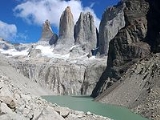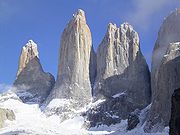
Cordillera del Paine
Encyclopedia
The Cordillera del Paine is a small but spectacular mountain group in Torres del Paine National Park
in Chile
an Patagonia
. It is located 280 km (174 mi) north of Punta Arenas
, and about 1,960 km south of the Chilean capital Santiago. It belongs to the Commune of Torres del Paine in Última Esperanza Province
of Magallanes y Antártica Chilena Region. No accurate surveys have been published, and published elevations have been claimed to be seriously inflated, so the elevations given on this page are all approximate.
 The highest summit of the range is probably Cerro Paine Grande, at 51°00′00"S 73°05′39"W. Its elevation is usually claimed to be 3,050 m but analysis of local photography suggests that it may be nearer to 2,750 m.
The highest summit of the range is probably Cerro Paine Grande, at 51°00′00"S 73°05′39"W. Its elevation is usually claimed to be 3,050 m but analysis of local photography suggests that it may be nearer to 2,750 m.
The best-known and most spectacular summits are the three Towers of Paine (Spanish
: Torres del Paine, 50°57′09"S 72°59′23"W). They are gigantic granite
monolith
s shaped by the forces of glacial ice.
The South Tower of Paine (about 2,500 m, at 50°57′33"S 72°59′42"W) is now thought to be the highest of the three, although this has not been definitely established. It was first climbed by Armando Aste
.
The Central Tower of Paine (about 2,460 m or 8,100 feet) was first climbed in 1963 by Chris Bonington
and Don Whillans
, and the North Tower of Paine (about 2,260 m) was first climbed by Guido Monzino
.
Other summits include the Cuerno Principal, about 2,100 m but often quoted at 2,600 m, and Cerro Paine Chico, which is usually correctly quoted at about 2,650 m.
The radiometric age for the quartz diorite at Cerro Payne is 12 ± 2 million years. by the rubidium-strontium method and 13 ± 1 million years. by the potassium-argon method.
by the UNESCO
in 1978 and is a popular hiking destination. There are clearly marked and well maintained paths and many refugios which provide shelter and basic services. Views are breathtaking.
Hikers can opt for a day trip to see the towers, walk the popular "W" route in about five days, or trek the full circle in 8–9 days.
The "W" route is by far the most popular, and is named for the shape of the route. Hikers start and finish at either of the base points of the "W", performing each of the three shoots as a day trip. The five points of the W, from west to east, are:
The longer "circuit" walk includes all the sights of the "W", but avoids most backtracking, by connecting Glacier Grey and the Torres del Paine around the back of the mountain range.
Boats and buses provide transport between Hosteria las Torres, Refugio Pehoe, and the park entrance at Laguna Amarga.
It is a national park and thus hikers are not allowed to stray from the paths. Camping is only allowed at specified campsites, and wood fires are prohibited in the whole park.
Torres del Paine National Park
Torres del Paine National Park is a national park encompassing mountains, a glacier, a lake, and river-rich areas in southern Chilean Patagonia. The Cordillera del Paine is the centerpiece of the park. It lies in a transition area between the Magellanic subpolar forests and the Patagonian Steppes...
in Chile
Chile
Chile ,officially the Republic of Chile , is a country in South America occupying a long, narrow coastal strip between the Andes mountains to the east and the Pacific Ocean to the west. It borders Peru to the north, Bolivia to the northeast, Argentina to the east, and the Drake Passage in the far...
an Patagonia
Patagonia
Patagonia is a region located in Argentina and Chile, integrating the southernmost section of the Andes mountains to the southwest towards the Pacific ocean and from the east of the cordillera to the valleys it follows south through Colorado River towards Carmen de Patagones in the Atlantic Ocean...
. It is located 280 km (174 mi) north of Punta Arenas
Punta Arenas, Chile
Punta Arenas is a commune and the capital city of Chile's southernmost region, Magallanes and Antartica Chilena. The city was officially renamed Magallanes in 1927, but in 1938 it was changed back to Punta Arenas...
, and about 1,960 km south of the Chilean capital Santiago. It belongs to the Commune of Torres del Paine in Última Esperanza Province
Última Esperanza Province
Última Esperanza Province is one of four provinces in the southern Chilean region of Magallanes and Antártica Chilena . The capital is Puerto Natales...
of Magallanes y Antártica Chilena Region. No accurate surveys have been published, and published elevations have been claimed to be seriously inflated, so the elevations given on this page are all approximate.
Peaks

The best-known and most spectacular summits are the three Towers of Paine (Spanish
Spanish language
Spanish , also known as Castilian , is a Romance language in the Ibero-Romance group that evolved from several languages and dialects in central-northern Iberia around the 9th century and gradually spread with the expansion of the Kingdom of Castile into central and southern Iberia during the...
: Torres del Paine, 50°57′09"S 72°59′23"W). They are gigantic granite
Granite
Granite is a common and widely occurring type of intrusive, felsic, igneous rock. Granite usually has a medium- to coarse-grained texture. Occasionally some individual crystals are larger than the groundmass, in which case the texture is known as porphyritic. A granitic rock with a porphyritic...
monolith
Monolith
A monolith is a geological feature such as a mountain, consisting of a single massive stone or rock, or a single piece of rock placed as, or within, a monument...
s shaped by the forces of glacial ice.
The South Tower of Paine (about 2,500 m, at 50°57′33"S 72°59′42"W) is now thought to be the highest of the three, although this has not been definitely established. It was first climbed by Armando Aste
Armando Aste
Armando Aste is one of the most influential Italian alpinists of the postwar period.Aste was born in Rovereto near Trento, Trentino. He led the first Italian ascent of the Eiger north face in 1962, together with Pierlorenzo Acquistapace, Gildo Airoldi, Andrea Mellano, Romano Perego and Franco Solina...
.
The Central Tower of Paine (about 2,460 m or 8,100 feet) was first climbed in 1963 by Chris Bonington
Chris Bonington
Sir Christian John Storey Bonington, CVO, CBE, DL is a British mountaineer.His career has included nineteen expeditions to the Himalayas, including four to Mount Everest and the first ascent of the south face of Annapurna.-Early life and expeditions:Educated at University College School in...
and Don Whillans
Don Whillans
Don Whillans was an English rock climber and mountaineer. Born and raised in a two-up two-down house in Salford, Lancashire, he climbed with both Joe Brown and Chris Bonington on many new routes, and was considered the technical equal of both. He was an apprentice plumber when he first started his...
, and the North Tower of Paine (about 2,260 m) was first climbed by Guido Monzino
Guido Monzino
Count Guido Monzino was a twentieth-century Italian mountain climber and explorer. In 1973 he led the first Italian expedition to climb Mount Everest.-Life:...
.
Other summits include the Cuerno Principal, about 2,100 m but often quoted at 2,600 m, and Cerro Paine Chico, which is usually correctly quoted at about 2,650 m.
The radiometric age for the quartz diorite at Cerro Payne is 12 ± 2 million years. by the rubidium-strontium method and 13 ± 1 million years. by the potassium-argon method.
Hiking
The Torres del Paine National Park—an area of 2,400 km²—was declared a Biosphere ReserveBiosphere reserve
The Man and the Biosphere Programme of UNESCO was established in 1971 to promote interdisciplinary approaches to management, research and education in ecosystem conservation and sustainable use of natural resources.-Development:...
by the UNESCO
UNESCO
The United Nations Educational, Scientific and Cultural Organization is a specialized agency of the United Nations...
in 1978 and is a popular hiking destination. There are clearly marked and well maintained paths and many refugios which provide shelter and basic services. Views are breathtaking.
Hikers can opt for a day trip to see the towers, walk the popular "W" route in about five days, or trek the full circle in 8–9 days.
The "W" route is by far the most popular, and is named for the shape of the route. Hikers start and finish at either of the base points of the "W", performing each of the three shoots as a day trip. The five points of the W, from west to east, are:
- Glacier Grey, a large glacier calvingIce calvingIce calving, also known as glacier calving or iceberg calving, is a form of ice ablation or ice disruption. It is the sudden release and breaking away of a mass of ice from a glacier, iceberg, ice front, ice shelf, or crevasse...
into the lake of the same name. Camping is available next to Refugio Grey. - Refugio Pehoe, situated on Lago Pehoe. This site offers good views of the "horns" of Torres del Paine.
- Valle del Francés ("Frenchman's Valley"), often rated as the best scenery in the whole park. The path leads up into a snowy dead-end, where several small glaciers are visible.
- Hosteria las Torres, a large hotel at the base of the mountain range.
- The Torres del Paine themselves, large rock formations over a small lake, high in the mountains.
The longer "circuit" walk includes all the sights of the "W", but avoids most backtracking, by connecting Glacier Grey and the Torres del Paine around the back of the mountain range.
Boats and buses provide transport between Hosteria las Torres, Refugio Pehoe, and the park entrance at Laguna Amarga.
It is a national park and thus hikers are not allowed to stray from the paths. Camping is only allowed at specified campsites, and wood fires are prohibited in the whole park.

